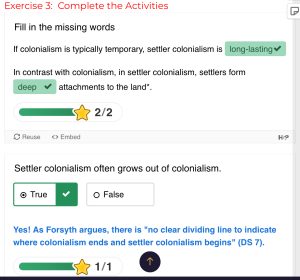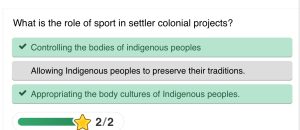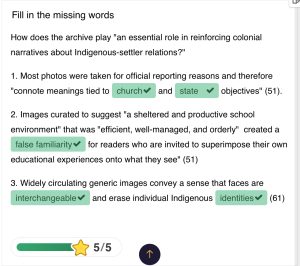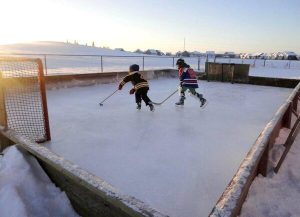4
These are difficult stories. We bear witness in this chapter to the role of sport in furthering the settler colonial projects throughout Turtle Island. Here are some supports to access in the community and from a distance:
First Peoples House of Learning Cultural Support & Counselling
Niijkiwendidaa Anishnaabekwag Services Circle (Counselling & Healing Services for Indigenous Women & their Families) – 1-800-663-2696
Nogojiwanong Friendship Centre (705) 775-0387
Peterborough Community Counselling Resource Centre: (705) 742-4258
Hope for Wellness – Indigenous help line (online chat also available) – 1-855-242-3310
LGBT Youthline: askus@youthline.ca or text (647)694-4275
National Indian Residential School Crisis Line – 1-866-925-4419
Talk4Healing (a culturally-grounded helpline for Indigenous women):1-855-5544-HEAL
Section One: History
A) The Residential School System
Exercise 1: Notebook Prompt
We are asked to honour these stories with open hearts and open minds.
Which part of the chapter stood out to you? What were your feelings as you read it? (50 words)
| The part of the chapter that stood out to me most was when it discussed a CBC article that was about hockey in residential schools. the article frames sport, particularly hockey, as a positive force in residential schools, presenting it almost as a antidote to the trauma that these horrid institutions caused. The use of well-groomed, smiling boys in hockey sweaters in the images paired alongside the article contributes to this narrative, reinforcing a sanitized and optimistic view of residential schools. Slapping a bandaid on a bullet hole and saying “all better!!’ This framing is troubled because it glosses over the deeper, much ore painful realities of these institutions, such as the emotional, physical and cultural abuse that Indigenous children endured after being forcefully stripped from their cultures and families. As I read this chapter, I felt very angry with a sense of unease. the idea that sport is portrayed as a redeeming or salvation all aspect of a system built on the forced assimilation of Indigenous children is a dismissal of the truth in the exorbitant amount of trauma faced by residential school victims and Indigenous communities as a whole. it is frustrating to see these efforts to present a “feel-good” story and how they may overshadow the real consequences of these schools, ill-educating those who are uninformed .
|
B) Keywords
Exercise 2: Notebook Prompt
Briefly define (point form is fine) one of the keywords in the padlet (may be one that you added yourself).
| Indian Act:
The Indian Act is a Canadian federal law that was passed in 1876. This Act governs matters that relate to Indigenous peoples in Canada and defines who is considered an “Indian” under Canadian law. The Act outlines how the federal government also should act with Indigenous communities. The Indian act provides a direct source of power to the government over Indigenous populations, giving them control over multiple aspects of Indigenous life, including the administration of reserves, the management of land, and the status of individuals based on various laid out criteria. Key features of the Indian act include band governance, control of Indian status, reserve land, and cultural supression. The Indian act is embedded in paternalistic and colonial ideology as it restricts the autonomy and authority of Indigenous peoples. Turtle Island: This is a term used by many Indigenous folk in North America to refer to the continent. Based in various Indigenous knowledges, truths, and creation stories, where earth is believed to have been formed on the back of a giant turtle. This term is significant as it symbolizes a rich spiritual connection to the land. Turtle island is a direct representation of Indigenous people’s respect for nature and their ties to the land.
|
C) Settler Colonialism
Exercise 3: Complete the Activities
If colonialism is typically temporary, settler colonialism is double
In contract with colonialism, in settler colonialism, settlers form deep attachments to the land
settler colonialism often grows out of colonialism : true
What is the role of sport in settler colonial projects?
– appropriating the body cultures of Indigenous peoples
– controlling


Exercise 4: Notebook Prompt
Although we have discussed in this module how the colonial project sought to suppress Indigenous cultures, it is important to note that it also appropriates and adapts Indigenous cultures and “body movement practices” (75) as part of a larger endeavour to “make settlers Indigenous” (75).
What does this look like? (write 2 or 3 sentences)
| The colonial project not only sought to suppress Indigenous cultures but also appropriated and adapted their practices to reinforce their settler identity. This often involved adopting Indigenous symbols, rituals, and body movement practices in ways that took away their original meaning and importance, allowing settlers to claim a sense of belonging to the land while distancing themselves from the violence and hatred of colonization. This serves to help settlers feel Indigenous by constructing a false narrative of shared heritage and connection. In doing so, as Forsyth and O’Bonsawin explain, it is a part of a broader effort to “make tethers Indigenous” allowing settlers to claim a sense of belonging to the land while continuing to marginalize Indigenous peoples and distancing themselves from the concerns of colonialism.
|
D) The Colonial Archive
Exercise 5: Complete the Activities
Section Two: Reconciliation
A) Reconciliation?
Exercise 6: Activity and Notebook Prompt
Visit the story called “The Skate” for an in-depth exploration of sport in the residential school system. At the bottom of the page you will see four questions to which you may respond by tweet, facebook message, or email:
How much freedom did you have to play as a child?
What values do we learn from different sports and games?
When residential staff took photos, what impression did they try to create?
Answer one of these questions (drawing on what you have learned in section one of this module or prior reading) and record it in your Notebook.
| When residential staff took pictures, what impression did they try to create?
In The Skate, residential school staff used happy-go-lucky photos of children playing sports, like skating, to create a false narrative and an illusionary depiction of happiness and normalcy. As if the removal of Indigenous children from their homes was at all a happy story. This hid the reality of abuse, neglect, and cultural oppression. Sports, while sometimes offering freedom, were we agonized to mask systemic harm.These joyful moments in time that were captured were brief seconds of escape for these innocent children, who just wanted to be loved and to be seen. The photos erase the painful context of their everyday lives. These pictures serve as propaganda to justify the horrid nature of the residential school system. It concealed the realities of forced assimilation, abuse, and cultural erosion.
|
B) Redefining Sport
B) Sport as Medicine
Exercise 7: Notebook Prompt
Make note of the many ways sport is considered medicine by the people interviewed in this video.
| Sport is medicine to a lot of people. To me, dance as a sport is my medicine. I grew up with a lot of anxiety and dealt with a fair share of bullying. However, when I was dancing, I was at peace – everything was still, silent, everyone and everything besides me. My body, along with everybody else’s, holds the power to express impactful stories through movement, not matter the sport. Without dance, I would not be my true, healed, self, and because of it I am forever greatful.
Lacrosse player Aidan Baker shares similar beliefs to mine, discussing how the sport of lacrosse is an important outlet for cultural reconnection. Aidan expresses that his grandfather is a residential school survivor, a common theme throughout this video, and lacrosse serves as his bridge to ancestral traditions. He emphasizes that lacrosse is a medicine – a secret gift from the creator that offers healing and spiritual connections. The next individual interviewed was William Nahanee, a residential school survivor. William discusses how participating in sports can provide therapeutic benefits and help people cope with life’s challenges. He opens up and expresses how sports gave him a sense of purpose and strength, helping him to navigate the long-lasting and horrible impacts of his experiences in the residential schools. Dr. Chief Robert Joseph was also interviewed, another residential school survivor, and reflects similarly on the role of sports in his life. He describes how sport brought him joy and a sense of accomplishment, just like William. He felt these impacts of sports despite the hardships he faced. Like the other interviewees, he stresses that sport has a powerful importance in uplifting and healing not only an individual but entire communities. Sport is a medicine that nurtures emotional, spiritual, cultural, and physical wellbeing. It has been a privilege to experience this first hand. |
C) Sport For development
Exercise 7: Notebook Prompt
What does Waneek Horn-Miller mean when she says that the government is “trying but still approaching Indigenous sport development in a very colonial way”?
| This statement, “trying but still approaching Indigenous sport development in a very colonial way.”, reflects her ultimate concern that despite efforts to support and include Indigenous althletes, the governmental approaches taken remain rooted in colonial frameworks that prioritize top-down decision-making processes that do not involve Indigenous communities in any part of the process. She highlights that these colonial ways overlook the importance of self-determination and unique ways Indigenous groups organize, value, and engage with sport. This idea reflects the legacy of colonial ideologies and historic discriminatory practices. This denial of autonomy within the discussion of sport leaves these initiatives failing to align with Indigenous cultural contexts, needs, and perspectives. Horn-Miller’s critique emphasizes the grave importance of adopting decolonized and empowering strategies that prioritize genuine collaboration, cultural sensitivity, and respect of Indigenous voices and knowledge in the development of sport programs. She says, “ They need to start understanding how to work with us, to understand how our people will come together to develop this.” I think this powerfully summarizes her main arguement and the critical need for indigenous knowledge not only within sport, but within all aspects of life. |
Exercise 8: Padlet Prompt
Add an image or brief comment reflecting some of “binding cultural symbols that constitute Canadian hockey discourse in Canada.” Record your responses in your Notebook as well.
|
I found an image of two kids playing hockey on a backyard Ice rink in the Canadian winter. I feel this is the epitome of Canadian hockey, where kids and adults come together on a homemade rink to enjoy time together and play hockey. This image, to me, reflects core ideas about Canadian identity and an emphasis on how winter (although gross, cold, and long) is a unifying experience. The homemade nature of hockey is something I find ceremonial as it is a learned and passed down thing that occurs in families and creates a sense of community as neighbours come together to shovel snow, share equipment, and cheer each other on. This image reinforces an idea that hockey is not just a sport but a binding tradition, deeply woven into the Canadian identity. I want to end this by tying it into the themes of decolonizing sport. We can reflect on ow hockey, often identified as a quintessential part of Canadian identity, has roots that intertwine with Indigenous cultures and yet their contributions are frequently overlooked, as with many other of their important ideas. While backyard rinks symbolizes community and tradition, it also raises questions about who has access to them, as many Indigenous people face poverty and live in remote areas that face systemic barriers and lack of infrastructure to create these homemade rinks. Acknowleding this is essential in decolonizing sports and expanding the homemade hockey story to include those who have had a longstanding history with stick-and-ball games.
|
Section Three: Decolonization
Please see the major assignment for this half of the term in the final section of this chapter.
Longer Prompt (5%)
Read the TRC’s 94 Calls to Action specific to sport again. Choose one of the Calls to Action that have been answered in full or in part and in 300 words explain the steps that have been taken to fulfill them and provide specific examples of what this looks like. Also reflect on how communities and individuals (particularly settlers) can Contribute to addressing these Calls to Action.
Call to Action 88 of the Truth and Reconciliation Committee strongly advises all levels of government to see to it that long-term Indigenous athlete development is supported. Additionally it calls for sustained support for the North American Indigenous Game (NAIG), including funding for hosting the games and for provincial and territorial team preparations and travel. While some substantial progress has been made (Indigenous Watch Dog, 2025), this call has not been fully considered, as systemic barriers to Indigenous athlete development continue to impose themselves upon Indigenous athletes.
The Canadian government has allocated $18.9 million to Indigenous sport initiatives, with ongoing funding of $5.5 million every four years, which supports the NAIG (Government of Canada, 2024). Additionally, Ontario also contributed to the 2017 Toronto NAIG, funding $3.5 million, demonstrating provincial-level investment (Ontario News, 2016). These demonstrations of financial commitment have helped NAIG continue and provides Indigenous youth with opportunities for competition, cultural connection, and intergenerational education. As identified in Indigenous Games Provide a Window into Culture, NAIG integrates language, ceremony, and traditional Indigenous sporting events such as canoeing and archery, which reinforces Indigenous ways of knowing (CBC News, 2017). This aspect of sport is crucial as it serves as a connection to intergenerational ideas of life and activity, mending the lasting wounds of cultural assimilation.
However, despite these financial advancements, gaps in support remain prominent. While NAIG receives federal support, many provinces and territories lack sustained funding for Indigenous-ed athlete development programs outside of the NAIG events (MacLean, 2023). Access remained limited in remote areas where sports infrastructure is not adequate, this demonstrates an ongoing inequality in sports.
Communities and settlers can be active contributors to success by advocating for consisten fundings across all provinces and territories, supporting Indigenous-led sporting events to increase visibility and by helping organizations like the Indigenous Sport and Wellness Ontario (ISWO) continue to support Indigenous athletes. Moreover, addressing systemic barriers, including racism within sports, by providing amplification and a platform to Indigenous sport governance is the critical component in this whole movement. As Sport is Medicine (BC Lions, 2022) highlights, sport is not merely a game for competition, it is a form of healing and cultural reclamation. True reconciliation requires structural reform that prioritizes Indigenous self-determination in sport and all areas of life and that starts with settlers and their voices, that have constantly boomed over Indigenous ones, giving a microphone to those communities to spread this important information and gain support.


